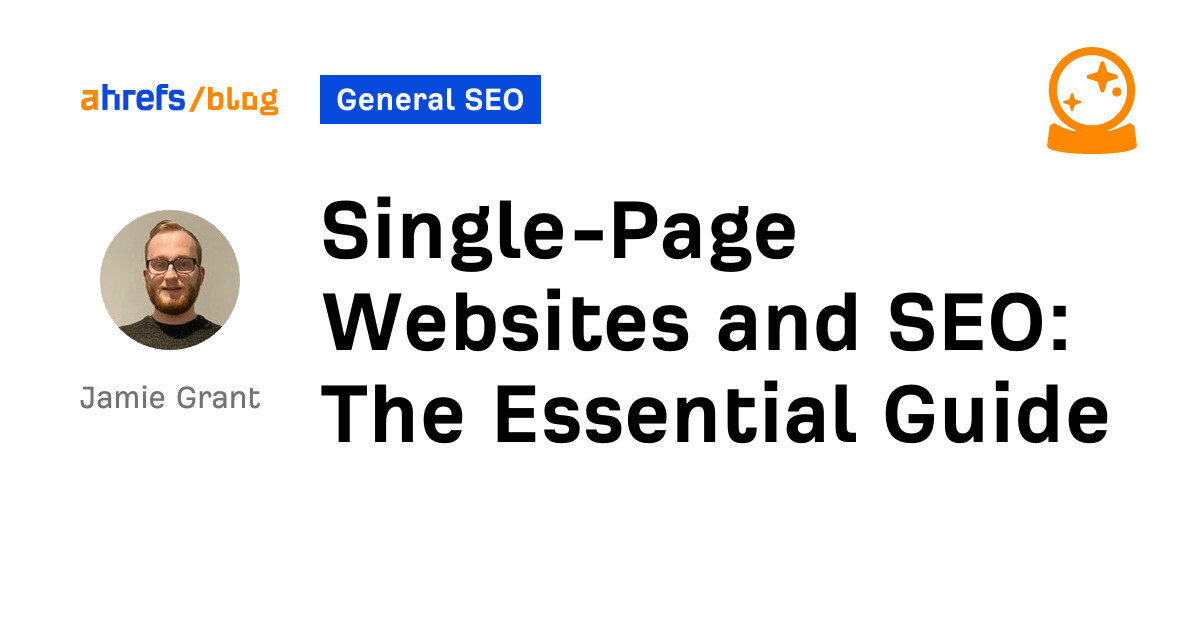[ad_1]
Virtually all Search engine marketing methods contain launching a number of pages on a web site. In most situations, that is undoubtedly the best way to go, however are you able to run a profitable Search engine marketing marketing campaign with only a single-page web site?
On this article, we’ll outline what a single-page web site is, evaluation whether or not it’s good or dangerous for Search engine marketing, and run by way of some high Search engine marketing suggestions for single-page web sites.
A single-page web site comprises all the website’s content material on just one touchdown web page. Not like multi-page web sites, the consumer is unable to navigate to content material on separate URLs by way of internal linking.
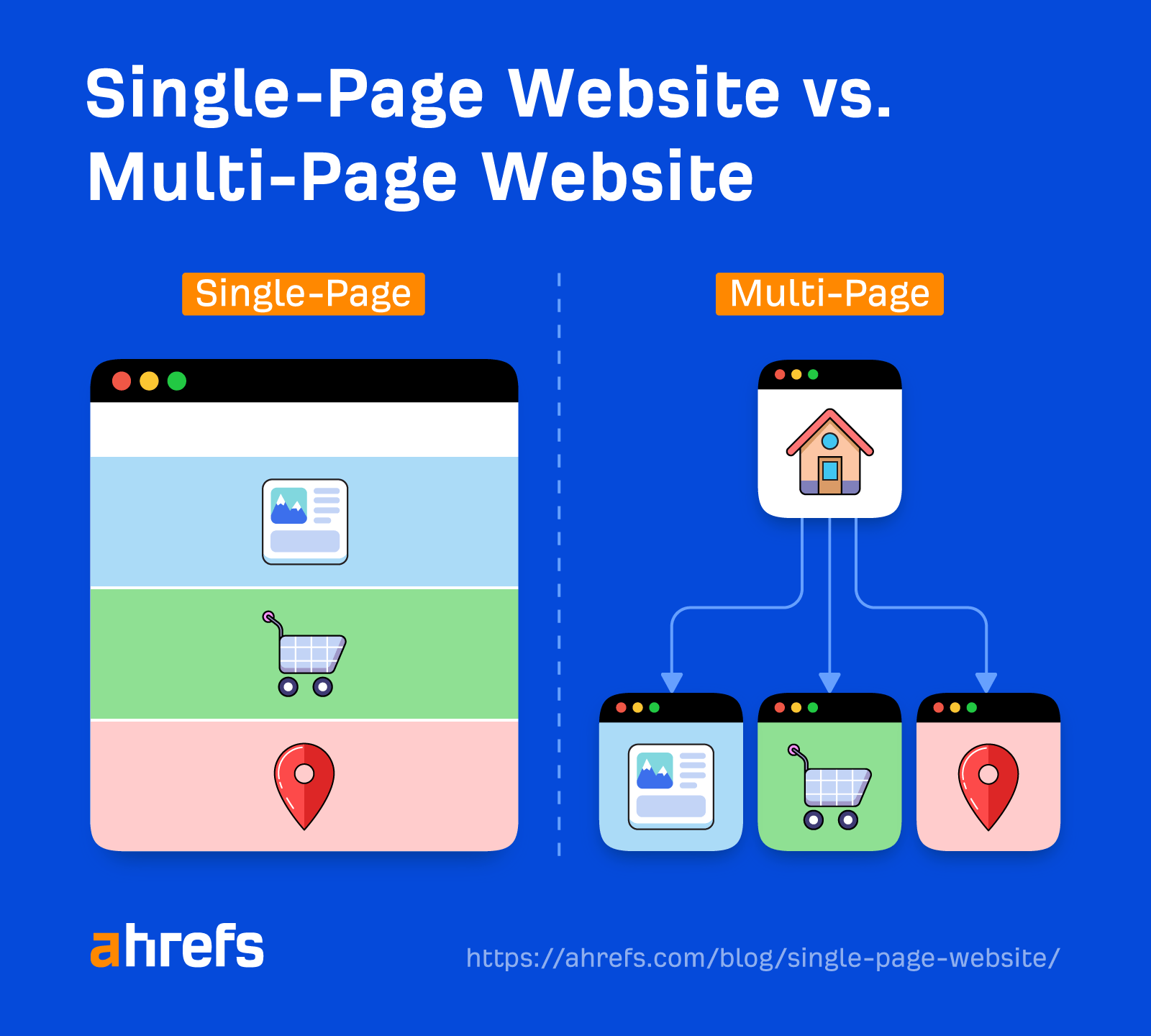
A single-page web site is just about what it says on the tin. It shouldn’t, nevertheless, be confused with a single-page software (SPA).
A SPA is a web site that hundreds all recordsdata by way of an online doc when the consumer first visits the web site. The remainder of the content material is then loaded dynamically as and when the consumer interacts with the website.
Inside a SPA, the consumer can nonetheless technically go to totally different pages. These are sometimes rendered “client-side” by way of JavaScript to dynamically serve the brand new content material.
In most situations, you’ll need to launch your web site with a couple of web page. Single-page web sites restrict your potential to develop natural visitors.
Listed here are my high explanation why single-page web sites aren’t good for Search engine marketing.
Lack of content material compromises key phrase focusing on
One of many largest points with a single-page web site is that you’re restricted to focusing on a small group of key phrases.
Whereas it’s potential to focus on totally different key phrases by way of a single touchdown web page, in Search engine marketing, it’s usually simpler to separate key phrase focusing on out by way of separate pages with a devoted focus.
This course of is also known as “keyword mapping,” the place key phrases are mapped to devoted touchdown pages primarily based on Google’s perceived search intent behind the key phrase.
One of the best ways to grasp the search intent behind a key phrase is to easily search the phrases manually and see what outcomes Google serves up. If Google ranks single-page web sites within the high positions on your focused question, then chances are high you possibly can rank within the high positions with a single web page too.
In my expertise, nevertheless, Google prefers to rank content material that’s tremendous related to the search time period. Even in the event you have been to focus on key phrases of various focuses by way of separate passages of content material on a single web page, you’ll be diluting the general relevancy of that web page. Splitting this content material out into hyper-focused touchdown pages is a much more optimum content material technique.
Constructing out a robust breadth of content material related to your area of interest additionally helps construct authority and topical relevance to your business within the eyes of Google.
Let’s say, for instance, you need to buy contact lenses. Retailer A gives a single product touchdown web page to buy the lenses.
Then again, Retailer B has the product web page, a “contact us” web page, and several other related and informative weblog posts answering frequent queries to do with contact lens eye care.
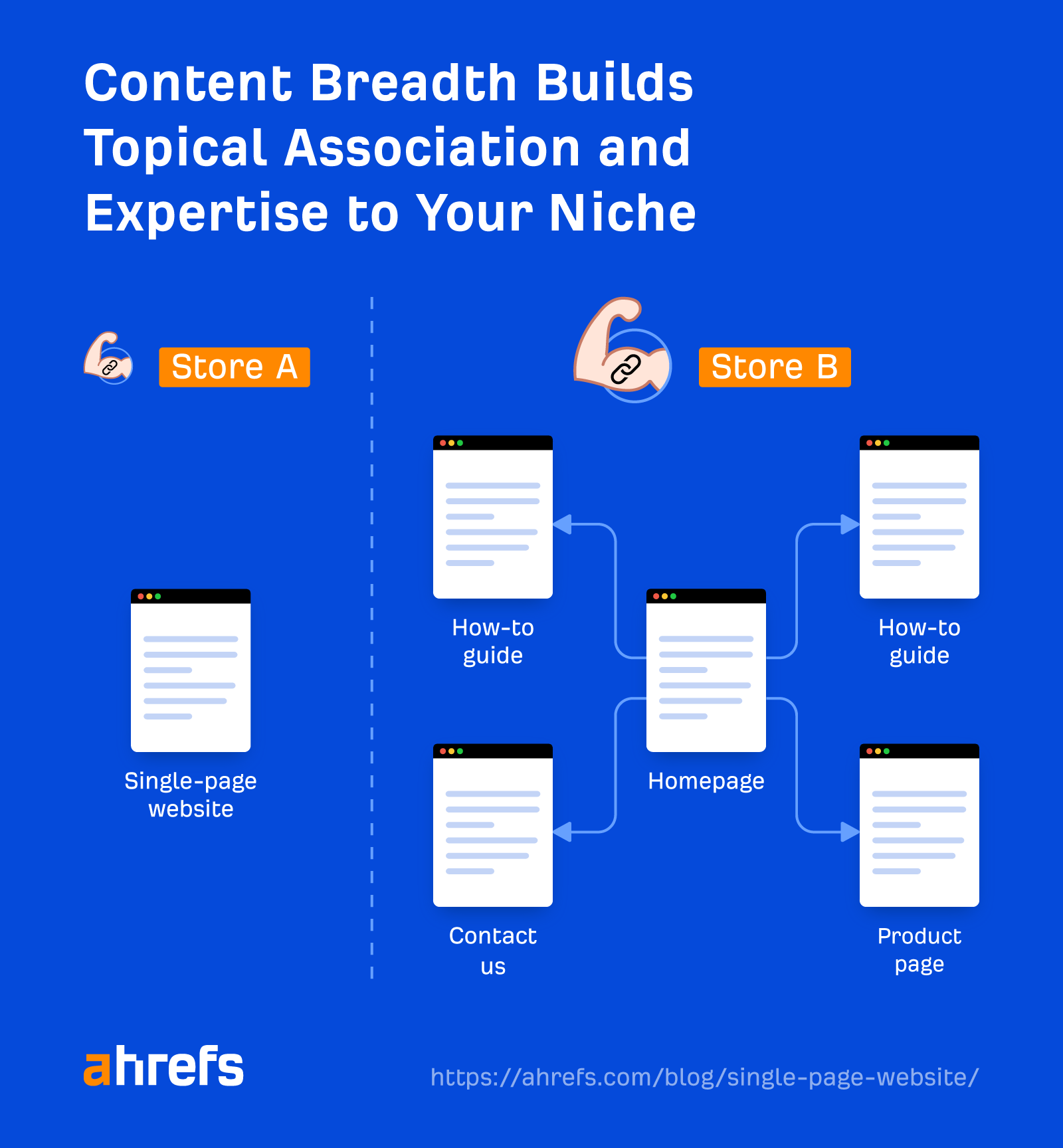
In fact, there’s far more at play right here. However usually, as a possible buyer, you’ll be extra more likely to belief Retailer B. Equally, within the eyes of Google, a wider breadth of reliable content material is a sign of expertise and builds topical relevance and affiliation to your area of interest.
Lack of construction and group results in poor consumer expertise
Single-page web sites usually lack clear construction and group. With all content material thrown right into a single web page, it’s frequent for customers to have a complicated and irritating expertise.
It is because the one manner for a consumer to navigate a single-page website is to scroll the web page and click on on anchor hyperlinks (if out there). The extra content material you squeeze onto a single web page, the extra irritating this expertise can turn into for the consumer, because it takes extra effort to seek out the specified content material.
Multi-page web sites sometimes have a transparent hierarchy of content material outlined by a header navigation menu and breadcrumbs. Customers are accustomed to navigating these setups. When configured accurately, these additionally present a seamless expertise for customers to hop between pages at their leisure.
Content material is commonly truncated to assist customers extra simply navigate a single-page web site. Nonetheless, this method does include its drawbacks. By streamlining your content material, you would be failing to incorporate data that your consumer is on the lookout for and stripping out content material with Search engine marketing worth.
Restricted potential to accumulate backlinks
Single-page web sites are sometimes transactional and conversion-focused. They sometimes embody minimal content material of an informational nature, akin to weblog posts, research, or campaign-style pages.
In my first Ahrefs weblog put up titled “Here’s Why You Should Prioritize Internal Linking,” I discussed how site owners sometimes hyperlink to content material of an informational nature versus a transactional one.
So by going for a single-page web site, you might be more likely to be compromising your capability to construct high quality backlinks.
Link building is without doubt one of the three key pillars of Search engine marketing. By rolling out a web site construction that’s removed from optimum for constructing hyperlinks, you’ll be limiting your rating potential.
Having a multi-page web site provides you extra flexibility to roll out extra of the content material that naturally attracts hyperlinks.
At this stage, you might be questioning why anybody would run a single-page web site. Though I’ve outlined loads of causes to not, a single-page web site could be the correct match for you at this second in time.
Many site owners could decide to run a single-page web site for the brief time period, with a view to increase and scale up their web site in the long run. On this occasion, a single-page web site makes for a pleasant placeholder or MVP model of a website.
They’re additionally comparatively low cost and simple to arrange. You solely want the useful resource to design, create, and host a single web page versus a number of pages.
These are some apparent non-Search engine marketing causes as to why single-page web sites often is the proper match for you. There are additionally some Search engine marketing advantages too.
They supply an awesome place to begin for model launches
If you’re within the strategy of launching a brand new model, you’ll possible be working relentlessly behind the scenes to make sure your full-scale web site is prepared for launch.
A single-page web site usually makes the proper placeholder website previous to a model’s launch (the place you’ll possible change to the complete web site upon launch). Having the single-page web site in place ensures Google has, on the very least, crawled and listed your web site in time for the model’s launch.
This helps to keep away from a state of affairs the place your model (and web site) launches with out being listed on Google. This could possibly be catastrophic, together with your web site doubtlessly lacking out on invaluable clicks on the massive day of your model’s launch.
Having at the least a single-page web site in place means that you can be listed and construct up essential rankings for key branded phrases forward of a launch.
PageRank is targeted on a single web page
I discussed earlier that it’s usually tougher to construct backlinks towards a single-page web site. That is definitely the case. Nonetheless, one benefit to having a single-page web site is that you’re much less more likely to undergo from PageRank dilution.
All backlinks which are constructed to your website will level towards a single URL. Because of this all PageRank constructed towards your website is related to a single web page, versus being diluted as authority is handed on by way of inside hyperlinks.
When PageRank is handed on by way of inside hyperlinks on multi-page web sites, barely much less and fewer of the general worth of that backlink is handed on. That is referred to as the “PageRank Damping Issue,” the place the worth handed on diminished with every “hop.”

Let’s say, for instance, we’ve Retailer A and Retailer B that promote the identical product, besides Retailer A is a single-page web site and Retailer B is a multi-page web site. They each obtain a backlink of the identical PageRank worth, focusing on the basis area of the respective web sites.
As a result of Retailer A’s product sits on the homepage (root area) as a single-page web site, this product receives the utmost worth from the backlink.
However Retailer B has to make use of an inside hyperlink to go on the PageRank from the homepage to the devoted product web page. As a result of the worth dampens by way of every inside hyperlink “hop,” Retailer B’s product doesn’t obtain as a lot of a PageRank increase as Retailer A’s.
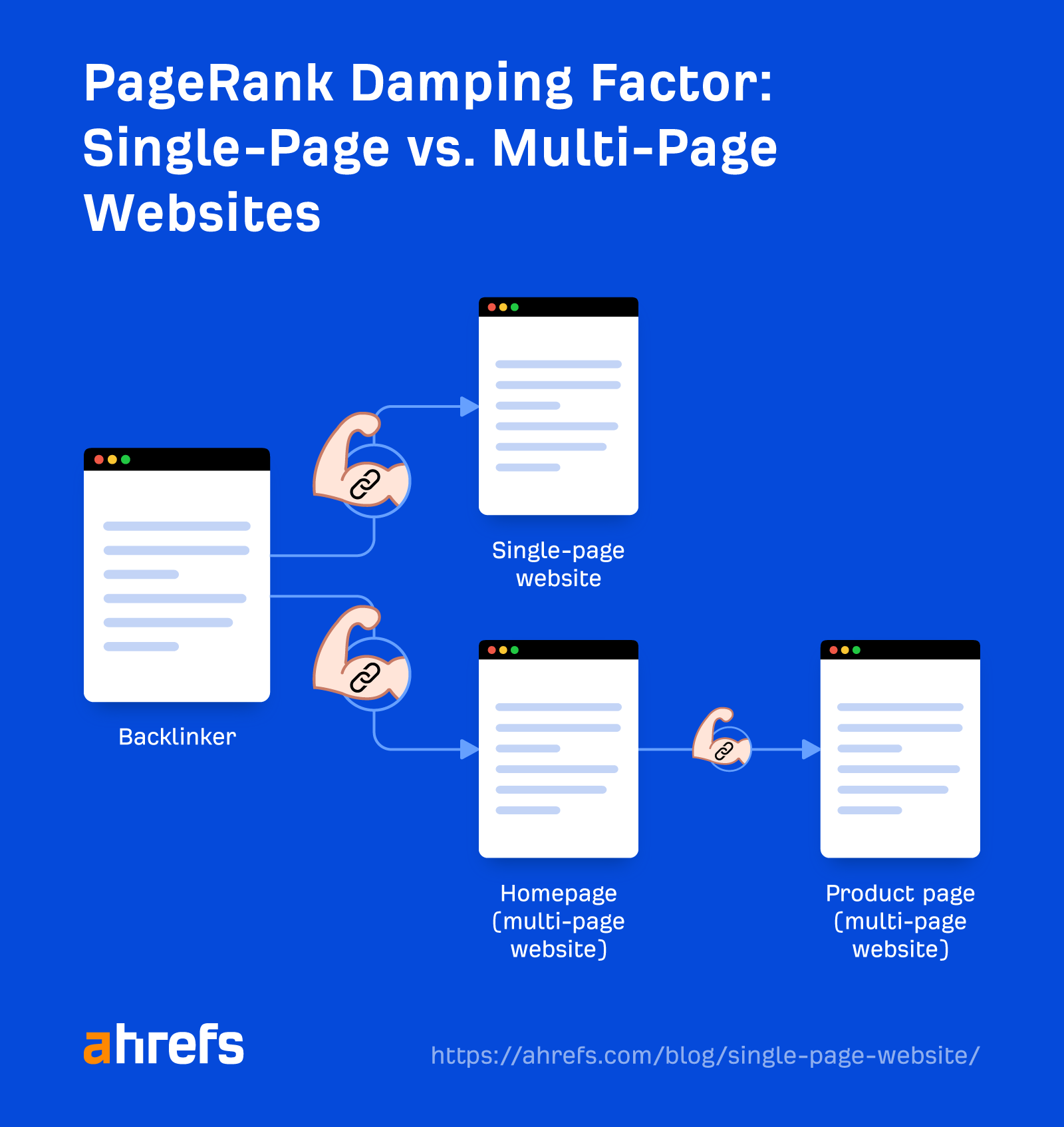
Having mentioned that, most often, I’d nonetheless go together with a multi-page web site on account of its pure capability to accumulate extra backlinks as compared.
They naturally supply a great expertise to cell customers
One other profit to single-page web sites is that they’re usually fairly optimum for cell customers in nature. In reality, they’re usually constructed with cell customers in thoughts.
Navigating by way of anchor hyperlinks usually lands nicely with cell customers, and the extra succinct and snappy nature of the copy is nicely aligned with cell optimization finest practices.
Guaranteeing your customers have good expertise by way of cell gadgets is extra necessary than ever. In line with Statista, a majority of all worldwide web site visits come from customers on cell gadgets.
Google may also predominantly crawl the cell model of your website and consider mobile-friendliness as a part of its rating alerts. It’s by no means been extra necessary to optimize for mobile.
So we’ve been by way of the benefits and downsides (referring to Search engine marketing) of working a single-page web site.
If a single-page web site is at present the correct choice for you, listed below are my high Search engine marketing suggestions for creating and working one.
Use a transparent hierarchy
As we highlighted earlier on, single-page web sites usually lack a transparent structure instilled by navigation menus and breadcrumbs.
With that in thoughts, you’ll need to set a transparent on-page hierarchy on your content material. Utilizing a logical heading construction consisting of a single H1 for the primary heading and H2s and H3s for the subheadings makes an awesome place to begin.

Utilizing these heading tags in a logical order to interrupt up your content material makes it simpler for customers to scan and navigate the web page. Having a messy heading construction forces your consumer to grasp the web page construction when navigating the web page.
That is much more essential for customers who’re visually impaired and could also be utilizing a display reader, so be certain to not skip out any heading ranges (e.g., nesting an H4 straight underneath an H2).
Don’t overlook picture optimization
Picture optimization is commonly neglected in Search engine marketing. Given how single-page web sites usually pack in a lot of imagery, image SEO shouldn’t be skipped.
There aren’t any further guidelines to observe in relation to single-page web sites, so make sure you observe finest practices such as:
- Utilizing descriptive alt textual content and file names.
- Compressing picture file sizes and utilizing next-gen file varieties.
- Loading photographs by way of a CDN (content material supply community).
Following these finest practices won’t solely help potential rankings by way of picture search but in addition improve web page pace efficiency.
Don’t neglect web page pace
This leads me properly to my subsequent tip; don’t neglect web page pace. Because it’s the one web page your customers will load, make sure you make it quick and responsive.
Positive, out of the lots of of rating alerts at play, web page pace isn’t on the high of the record in relation to Search engine marketing priorities. Nonetheless, it’s laborious to disregard that having a quick and responsive web site helps not solely natural rankings but in addition consumer expertise.
Discussing Core Net Vitals on Reddit, John Mueller described Core Net Vitals as being “greater than a tie breaker” sign.
Think with Google states that 53% of visits are deserted if a cell website takes longer than three seconds to load.
Couple these factors collectively, and we’ve a fairly good case for making certain web page pace stays a related consideration.
Lazy-loading below-the-fold content material ought to be a key consideration for single-page web sites. It is because you’ll possible be packing in additional content material than ordinary into the one web page, weighing down web page load occasions.
Because of this any assets that require the consumer to scroll with the intention to be seen will probably be delayed within the preliminary web page load. As a substitute, these assets will load because the consumer scrolls.
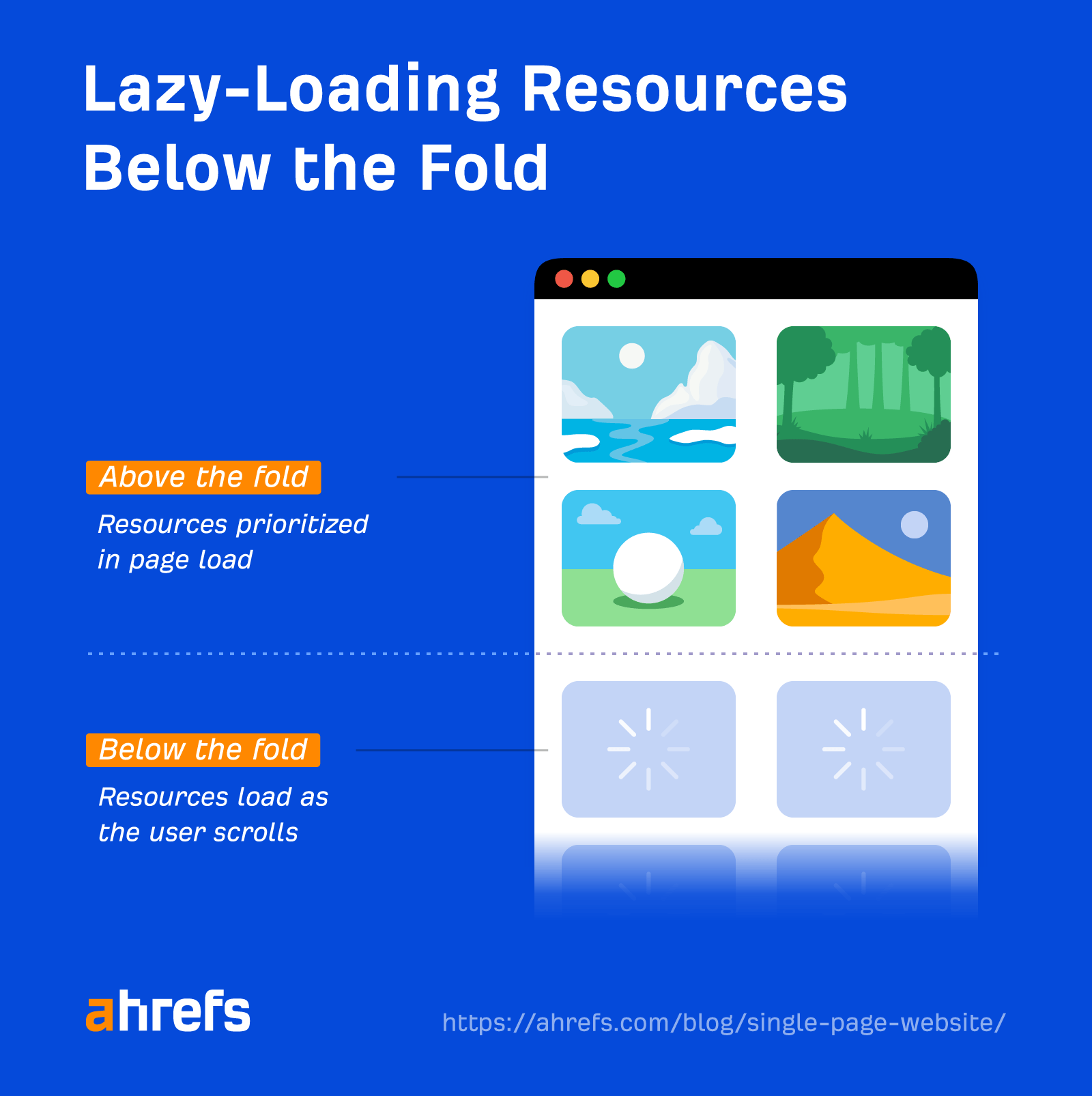
Double down on hyperlink constructing
As we talked about earlier within the article, single-page web sites undergo in relation to naturally pulling in backlinks. With this in thoughts, you’ll possible need to dedicate much more time to hyperlink constructing than ordinary.
You’ll must double down on methods that don’t require the creation of recent pages.
It is because you might be unable to roll out pages devoted to attracting hyperlinks, for instance, utilizing methods akin to link baiting.
Offering skilled feedback/quotes for third-party web sites is a good way to construct hyperlinks with out the necessity to launch new pages.
The method is fairly easy:
- A journalist shares a request for an skilled remark.
- You pitch to supply a remark.
- If profitable, the journalist contains your remark of their piece.
There’s no assure the journalist will really embody a backlink alongside the remark. That mentioned, there’s a robust likelihood the journalist will embody a hyperlink to credit score the contributor. When you begin to construct up the skilled feedback, the backlinks will begin to construct up too.
In the case of discovering journalist requests for skilled feedback, Twitter makes an awesome place to begin. Journalists will usually embody #journorequest, making it simple to seek out related requests with a customized search.
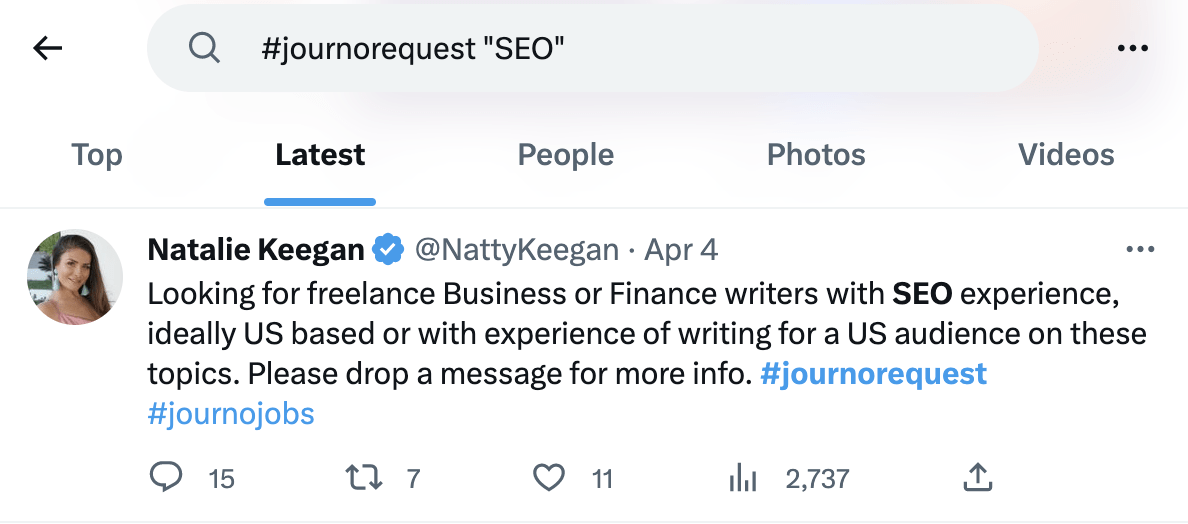
There are additionally loads of third-party platforms that journalists will use to submit such requests, akin to HARO.
Discovering unlinked model mentions is one other nice technique for constructing backlinks the place you don’t want to create any new content material.
An unlinked model point out is an internet point out (quotation) of your model identify or perhaps a key spokesperson out of your firm the place the writer doesn’t embody a backlink.
General, the method is comparatively simple:
- Uncover model mentions by way of Ahrefs’ Content Explorer
- Crawl the mentions with a customized search to filter out pages that already present a hyperlink
- Carry out outreach to the publishers that don’t hyperlink, requesting that they add a hyperlink
Ahrefs’ Joshua Hardwick has supplied an in depth information on changing unlinked brand mentions into backlinks. It’s nicely value a learn for extra particulars on the above steps.
These are simply two examples of hyperlink constructing methods that don’t require content material. Take a look at “9 Easy Link Building Strategies (That Anyone Can Use)” for eight extra legitimate methods that I haven’t talked about right here.
Comply with on-page finest practices
My final tip is a fairly easy one, however it’s in all probability one of the crucial essential suggestions. Following on-page SEO best practices is a should.
You can be restricted by the constraints of getting only a single web page, so that you’ll need to forgo inside linking, for instance.
That mentioned, it stays important to optimize key on-page parts, from meta titles and descriptions to key phrase focusing on.
Ultimate ideas
Single-page web sites aren’t for everyone. Usually, I personally will go for a multi-page setup as a substitute.
That mentioned, there are some situations the place a single-page web site is sensible, notably as a short-term resolution or MVP model of a web site.
Key takeaways:
- Key phrase focusing on is compromised on account of an absence of content material.
- Single-page web sites battle to construct and present experience.
- You’ll must double down on hyperlink constructing, as single-page web sites naturally purchase fewer backlinks.
Have any questions? Ping me on Twitter and let me know.
[ad_2]
